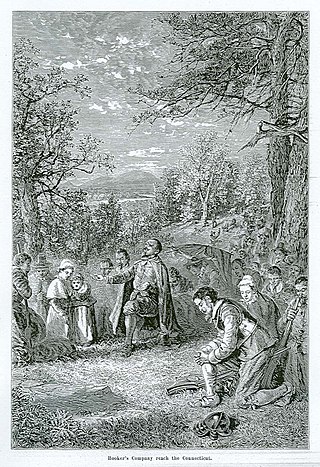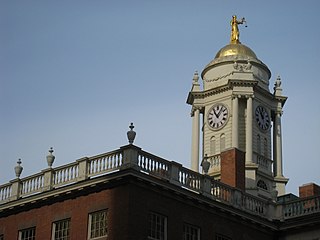
Connecticut is the southernmost state in the New England region of the Northeastern United States. It borders Rhode Island to its east, Massachusetts to its north, New York to its west, and Long Island Sound to its south. Its capital is Hartford, and its most populous city is Bridgeport. Historically, the state is part of New England as well as the tri-state area with New York and New Jersey. The state is named for the Connecticut River which approximately bisects the state. The word Connecticut is derived from various anglicized spellings of Quinnetuket, a Mohegan-Pequot word for "long tidal river". As of the 2020 United States census, Connecticut was home to over 3.6 million residents, its highest decennial count ever, growing every decade since 1790.

Thomas Hooker was a prominent English colonial leader and Congregational minister, who founded the Connecticut Colony after dissenting with Puritan leaders in Massachusetts. He was known as an outstanding speaker and an advocate of universal Christian suffrage.

The Fundamental Orders were adopted by the Connecticut Colony council on January 24 [O.S. January 14] 1639. The fundamental orders describe the government set up by the Connecticut River towns, setting its structure and powers. They wanted the government to have access to the open ocean for trading.

The Connecticut General Assembly (CGA) is the state legislature of the U.S. state of Connecticut. It is a bicameral body composed of the 151-member House of Representatives and the 36-member Senate. It meets in the state capital, Hartford. There are no term limits for either chamber.

The Connecticut Colony or Colony of Connecticut, originally known as the Connecticut River Colony or simply the River Colony, was an English colony in New England which later became Connecticut. It was organized on March 3, 1636 as a settlement for a Puritan congregation, and the English permanently gained control of the region in 1637 after struggles with the Dutch. The colony was later the scene of a bloody war between the colonists and Pequots known as the Pequot War. Connecticut Colony played a significant role in the establishment of self-government in the New World with its refusal to surrender local authority to the Dominion of New England, an event known as the Charter Oak incident which occurred at Jeremy Adams' inn and tavern.

John Haynes, also sometimes spelled Haines, was a colonial magistrate and one of the founders of the Connecticut Colony. He served one term as governor of the Massachusetts Bay Colony and was the first governor of Connecticut, ultimately serving eight separate terms. Although Colonial Connecticut prohibited Governors from serving consecutive terms at the time, "John Haynes was so popular with the colonists that he served alternately as governor and often as deputy governor from 1639 to his death in 1653."

Roger Ludlow (1590–1664) was an English lawyer, magistrate, military officer, and colonist. He was active in the founding of the Colony of Connecticut, and helped draft laws for it and the nearby Massachusetts Bay Colony. Under his and John Mason's direction, Boston's first fortification, later known as Castle William and then Fort Independence was built on Castle Island in Boston harbor. Frequently at odds with his peers, he eventually also founded Fairfield and Norwalk before leaving New England entirely.

The Connecticut State House of Representatives is the lower house in the Connecticut General Assembly, the state legislature of the U.S. state of Connecticut. The house is composed of 151 members representing an equal number of districts, with each constituency containing nearly 22,600 residents. Representatives are elected to two-year terms with no term limits. The House convenes within the Connecticut State Capitol in Hartford.

The Connecticut State Senate is the upper house of the Connecticut General Assembly, the state legislature of the U.S. state of Connecticut. The state senate comprises 36 members, each representing a district with around 99,280 inhabitants. Senators are elected to two-year terms without term limits. The Connecticut State Senate is one of 14 state legislative upper houses whose members serve two-year terms; four-year terms are more common.

The Constitution of the State of Connecticut is the basic governing document of the U.S. state of Connecticut. It was approved by referendum on December 14, 1965, and proclaimed by the governor as adopted on December 30. It comprises 14 articles and has been amended 31 times.

The Connecticut General Statutes, also called the General Statutes of Connecticut and abbreviated Conn. Gen. Stat., is a codification of the law of Connecticut. Revised to 2017, it contains all of the public acts of Connecticut and certain special acts of the public nature, the Constitution of the United States, the Amendments to the Constitution of the United States, and the Constitution of the State of Connecticut, including its 31 amendments adopted since 1965. The earliest predecessor to the currently in force codification dates to 1650.

The History of Hartford, Connecticut has occupied a central place in Connecticut's history from the state's origins to the present, as well as the greater history of the United States of America.

The Connecticut State Library is the state library for the U.S. state of Connecticut and is also an executive branch agency of the state. It is located in Hartford, Connecticut directly across the street from the Connecticut State Capitol. The State Library provides a variety of library, information, archival, public records, museum, and administrative services to the citizens of Connecticut, as well as the employees and officials of all three branches of state government. Students, researchers, public libraries and town governments throughout the state are also served by the State Library. In addition, the State Library directs a program of statewide library development and administers the Library Services Technology Act state grant. "The mission of the Connecticut State Library is to preserve and make accessible Connecticut's history and heritage and to advance the development of library services statewide."
Connecticut is known as "The Constitution State". The origin of this title is uncertain, but the nickname is assumed to be a reference to the Fundamental Orders of 1638–39 which represent the framework for the first formal government written by a representative body in Connecticut. Connecticut's government has operated under the direction of five separate documents in its history. The Connecticut Colony at Hartford was governed by the Fundamental Orders, and the Quinnipiac Colony at New Haven had its own Constitution in The Fundamental Agreement of the New Haven Colony which was signed on 4 June 1639.

The following outline is provided as an overview of and topical guide to the U.S. state of Connecticut:

The establishment of lesbian, gay, bisexual, and transgender (LGBT) rights in the U.S. state of Connecticut is a recent phenomenon, with most advances in LGBT rights taking place in the late 20th century and early 21st century. Connecticut was the second U.S. state to enact two major pieces of pro-LGBT legislation; the repeal of the sodomy law in 1971 and the legalization of same-sex marriage in 2008. State law bans unfair discrimination on the basis of sexual orientation and gender identity in employment, housing and public accommodations, and both conversion therapy and the gay panic defense are outlawed in the state.

Jeremy Adams, also known as Jeremiah Adams, was one of the first settlers of Hartford, Connecticut. He was also the founder and first proprietor of Colchester, Connecticut, which was established on land owned by Adams, known as "Jeremiah's Farme".
The law of Virginia consists of several levels of legal rules, including constitutional, statutory, regulatory, case law, and local laws. The Code of Virginia contains the codified legislation that define the general statutory laws for the Commonwealth.
The law of North Carolina consists of several levels, including constitutional, statutory, regulatory, case law, and local law.
The law of Washington consists of several levels, including constitutional, statutory, regulatory and case law, as well as local ordinances. The Revised Code of Washington forms the general statutory law.















